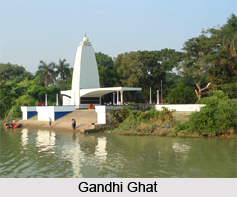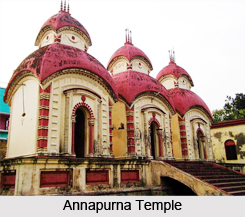 Monuments in Barrackpur comprise of some of the major constructions during the British rule in India. Once served as the summer residence of the British Governors-General, Barrackpur is situated at a distance of twenty four kilometers to the north of Kolkata, on the banks of the River Hooghly, opposite to the former Danish colony of Serampore. Barrackpur was established in the form of a cantonment in the year 1775, and quickly became one of the prominent places in India. The layout is typical, with broad avenues of detached bungalows, each set in its own garden compound. Some of the bungalows are original and there are a variety of attractive neo-classical styles.
Monuments in Barrackpur comprise of some of the major constructions during the British rule in India. Once served as the summer residence of the British Governors-General, Barrackpur is situated at a distance of twenty four kilometers to the north of Kolkata, on the banks of the River Hooghly, opposite to the former Danish colony of Serampore. Barrackpur was established in the form of a cantonment in the year 1775, and quickly became one of the prominent places in India. The layout is typical, with broad avenues of detached bungalows, each set in its own garden compound. Some of the bungalows are original and there are a variety of attractive neo-classical styles.
Marquess Wellesley, the elder brother of the Duke of Wellington, started to construct a summer retreat here, but the same was never completed. The long avenue of mature trees lining the road from Kolkata is the only vestige of Wellesley`s original grandiose vision of a continuous processional route from the city. There are a number of interesting monuments and buildings, but access is restricted. The Government House was planned by Captain Thomas Anbury in the year 1813. The main north faqade is enriched with an octa-style Tuscan entrance portico and shallow pediment. Colonnaded verandahs enclose the other three sides. The house was never spacious. Guests were provided accommodation in a series of bungalows dispersed around the park. It is now a police hospital and the large first-floor drawing-room is a typhoid ward. Once the greatest delight was its setting by the Hooghly River, but the beautiful setting of the landscaped gardens are now sadly overgrown and the building is dilapidated. An exotic menagerie was constructed here in the 1820s, but no trace now remains of the neo-classical pavilions and Gothic aviaries which Bishop Heber came across. The marble fountain and basin situated in close proximity to the house once formed part of the Mughal baths at Agra and were imported by Lord Warren Hastings. A number of other interesting monuments also remain there.
The Temple of Fame, constructed by Captain George Rodney Blanc is located between the main house and Commander-in-Chief`s bungalow. It looks like an elegant Greek temple, embellished with hexastyle Corinthian porticos at each end and colonnades to the flanks. It was constructed by the Earl of Minto to commemorate the soldiers who fell in the conquest of Mauritius and Java from the year 1810 and 1811. The memorial chamber is a simple barrel vault with four black commemorative plaques and an inscription over the entrance. A later tablet erected in the year 1843, memorializes the Gwalior Campaign. Around the building are discarded statues of King George V, Peel, Minto, Mayo, Lansdowne, Roberts, Woodburn and Napier of Magdala, relocated here by the Kolkata authorities.
 The Grave of Lady Canning is another monument of importance which can be seen while on a tour of Barrackpur. Lady Charlotte Canning died of fever at Barrackpur on the 18th of November 1861. She was interred beside the River Hooghly in the gardens which she did so much to enhance its beauty. Her grave is located in a small enclosure, with iron-work designed from the intertwined initials of her name, C. C. The distinctive memorial, crowned by the Cross of St Andrew, is a replica; the original, by George Gilbert Scott, was relocated to the north portico of St John`s Church, Kolkata. In a touching gesture the equestrian statue of her husband, Lord Canning, was moved here from Kolkata after independence and placed beside her grave. Close to it is the famous banyan tree, from which the first sepoy mutineer, Mangal Pandey, was hanged in the month of March, 1857.
The Grave of Lady Canning is another monument of importance which can be seen while on a tour of Barrackpur. Lady Charlotte Canning died of fever at Barrackpur on the 18th of November 1861. She was interred beside the River Hooghly in the gardens which she did so much to enhance its beauty. Her grave is located in a small enclosure, with iron-work designed from the intertwined initials of her name, C. C. The distinctive memorial, crowned by the Cross of St Andrew, is a replica; the original, by George Gilbert Scott, was relocated to the north portico of St John`s Church, Kolkata. In a touching gesture the equestrian statue of her husband, Lord Canning, was moved here from Kolkata after independence and placed beside her grave. Close to it is the famous banyan tree, from which the first sepoy mutineer, Mangal Pandey, was hanged in the month of March, 1857.
Semaphore Tower is located immediately adjacent to the former Flagstaff Bungalow. It is a local landmark, an old circular semaphore tower, crowned by a small ball, one of a chain of signal stations which was previously used for communicating rapidly up river before the advent of the electric telegraph. A number of Staff Bungalows were constructed in the year 1863. To the west of Government House is the Flagstaff Bungalow, originally occupied by the Private Secretary and later by the Commander-in-Chief. To the north arc three other bungalows of a similar date and style, which replaced some earlier `Swiss Cottages`, are present. In the grounds of the bungalow once occupied by Lord Kitchener is a garden memorial to the horse Myall King, three times winner of the Calcutta Cup, who died dramatically on the Kolkata racecourse in the year 1893. The Parade Ground at Barrackpur is well-known as the first scene in the terrible chapter of the Sepoy Mutiny in the year 1857. The mutinous 19th Regiment was disbanded here and ten days later, on 29th March, the rebellious Mangal Pande ran amok.
Situated in close proximity to the Parade Ground is St Bartholomew`s Church, opened in the year 1831, consecrated in the year 1847, and altered in 1868, when the tower, chancel, verandahs and western porch were added in a crude classical style reminiscent of Soanc`s primitivist order. The font in the transept was the gift of Lord Ellenborough. Several other interesting monuments, including one to Major Arthur William Fitzroy Somerset, who laid down his life in the Sikh War of 1845, and another to Frederick Sherwood Taylor, who was `overwhelmed` by the dreadful landslip at Naini Tal in the year 1880. The Old Cemetery in Barrackpur possesses a large number of military graves.
A witness to one of the gripping historical outbreaks of the Sepoy Mutiny of 1857, Barrackpur offers a number of historical monuments. The renowned outbreak of 1857 originated in this place. This single event made Barrackpur known all over the world. Apart from its association with the Sepoy Mutiny, Barrackpur also possesses various other historical monuments which attract people throughout the year. Some of the places of interest in Barrackpur include the Gandhi Ghat, Adyapith Mandir, Gandhi Museum, Udyan Bati, Mandir of Hanumana, Nand Kishore Temple, Lat Bagan, Annapurna Temple, Mandir of Laxmi Narayan, Prem Chand Sata Barshiki Bhawan, etc.



















